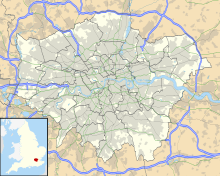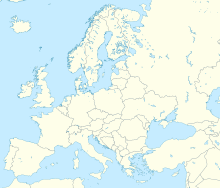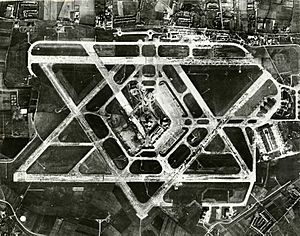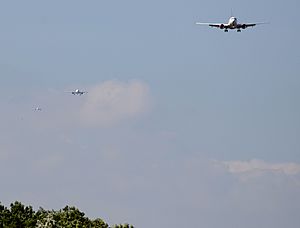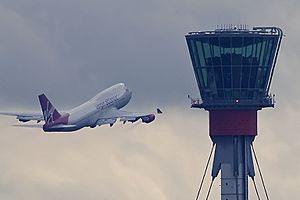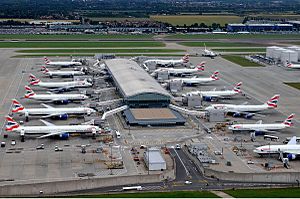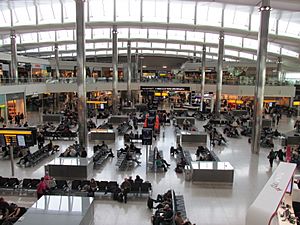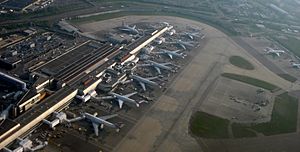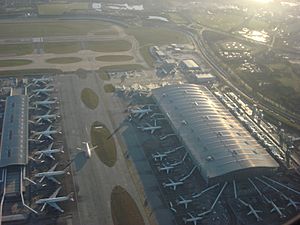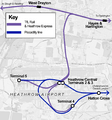Heathrow Airport facts for kids
Quick facts for kids
London Heathrow Airport
|
|||||||||||||||
|---|---|---|---|---|---|---|---|---|---|---|---|---|---|---|---|
 |
|||||||||||||||
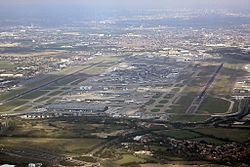 |
|||||||||||||||
| Summary | |||||||||||||||
| Airport type | Public | ||||||||||||||
| Owner/Operator | Heathrow Airport Holdings | ||||||||||||||
| Serves | Greater London, Berkshire, southern Buckinghamshire, northwest Surrey and western Hertfordshire | ||||||||||||||
| Location | Hillingdon, London, England | ||||||||||||||
| Opened | 25 March 1946 | ||||||||||||||
| Hub for | British Airways | ||||||||||||||
| Focus city for | Virgin Atlantic | ||||||||||||||
| Elevation AMSL | 83 ft / 25 m | ||||||||||||||
| Coordinates | 51°28′39″N 000°27′41″W / 51.47750°N 0.46139°W | ||||||||||||||
| Map | |||||||||||||||
| Runway | |||||||||||||||
|
|||||||||||||||
| Statistics (2020) | |||||||||||||||
|
|||||||||||||||
|
Sources:
Statistics from the CAA and Heathrow Airport Limited |
|||||||||||||||
Heathrow Airport, originally called London Airport until 1966 and now known as London Heathrow (IATA: LHR, ICAO: EGLL), is a major international airport in London, England. With Gatwick, City, Luton, Stansted and Southend, it is the largest of the six international airports serving London. The airport facility is owned and operated by Heathrow Airport Holdings. In 2021, it was the seventh-busiest airport in the world by international passenger traffic and eighth-busiest in Europe by total passenger traffic.
Heathrow was founded as a small airfield in 1929, but was developed into a much larger airport after World War II. The airport, which lies 14 miles (23 km) west of Central London on a site that covers 12.27 square kilometres (4.74 sq mi), gradually expanded over the next seventy-five years, and now has two parallel east–west runways along with four operational passenger terminals, and one cargo terminal. The airport is the primary hub for British Airways and the primary operating base for Virgin Atlantic; in 2020, it handled 22.1 million passengers, a 72.4% drop from 2019, as well as 207,070 aircraft movements.
Contents
Location
Heathrow is 14 mi (23 km) west of central London, near the south end of the London Borough of Hillingdon on a parcel of land that is designated part of the Metropolitan Green Belt. The airport is surrounded by the built-up areas of Harlington, Harmondsworth, Longford and Cranford to the north and by Hounslow and Hatton to the east. To the south lie Bedfont and Stanwell while to the west Heathrow is separated from Slough in Berkshire by the M25 motorway. Heathrow falls entirely under the TW postcode area.
As the airport is west of London and as its runways run east–west, an airliner's landing approach is usually directly over the conurbation of London when the wind is from the west.
Along with Gatwick, Stansted, Luton, Southend and London City, Heathrow is one of six airports with scheduled services serving the London area, although only Heathrow and London City are within Greater London.
History
- For a chronicled history of Heathrow Airport, see History of Heathrow Airport.
Heathrow Airport originated in 1929 as a small airfield (Great West Aerodrome) on land south-east of the hamlet of Heathrow from which the airport takes its name. At that time there were farms, market gardens and orchards there: there was a "Heathrow Farm" about where Terminal 1 is now, a "Heathrow Hall" and a "Heathrow House". This hamlet was largely along a country lane (Heathrow Road) which ran roughly along the east and south edges of the present central terminals area.
Development of the whole Heathrow area as a very much larger airport began in 1944: it was stated to be for long-distance military aircraft bound for the Far East. But by the time the airfield was nearing completion, World War II had ended. The government continued to develop the airport as a civil airport; it opened as London Airport in 1946 and was renamed Heathrow Airport in 1966. The masterplan for the airport was designed by Sir Frederick Gibberd, who designed the original terminals and central area buildings, including the original control tower and the multi-faith chapel of St George's.
Operations
Facilities

Heathrow Airport is used by over 80 airlines flying to 185 destinations in 84 countries. The airport is the primary hub of British Airways and is a base for Virgin Atlantic. It has four passenger terminals (numbered 2 to 5) and a cargo terminal. Of Heathrow's 73.4 million passengers in 2014, 93% were international travellers; the remaining 7% were bound for (or arriving from) places in the UK. The busiest single destination in passenger numbers is New York, with over 3 million passengers flying between Heathrow and JFK Airport in 2013.
In the 1950s, Heathrow had six runways, arranged in three pairs at different angles in the shape of a hexagram (✡) with the permanent passenger terminal in the middle and the older terminal along the north edge of the field; two of its runways would always be within 30° of the wind direction. As the required length for runways has grown, Heathrow now has only two parallel runways running east–west. These are extended versions of the two east–west runways from the original hexagram. From the air, almost all of the original runways can still be seen, incorporated into the present system of taxiways. North of the northern runway and the former taxiway and aprons, now the site of extensive car parks, is the entrance to the access tunnel and the site of Heathrow's unofficial "gate guardian". For many years the home of a 40% scale model of a British Airways Concorde, G-CONC, the site has been occupied by a model of an Emirates Airbus A380 since 2008.
Heathrow Airport has Anglican, Catholic, Free Church, Hindu, Jewish, Muslim and Sikh chaplains. There is a multi-faith prayer room and counselling room in each terminal, in addition to St. George's Interdenominational Chapel in an underground vault adjacent to the old control tower, where Christian services take place. The chaplains organise and lead prayers at certain times in the prayer room.
The airport has its own resident press corps, consisting of six photographers and one TV crew, serving all the major newspapers and television stations around the world.
Most of Heathrow's internal roads are initial letter coded by area: N in the north (e.g. Newall Road), E in the east (e.g. Elmdon Road), S in the south (e.g. Stratford Road), W in the west (e.g. Walrus Road), C in the centre (e.g. Camborne Road).
Flight movements
Aircraft destined for Heathrow are usually routed over one of four main reporting points: Bovingdon (BNN) in Hertfordshire, Lambourne (LAM) in Essex, Biggin Hill (BIG) in Bromley and Ockham (OCK) in Surrey. Each is defined by a VOR radio-navigational beacon. When the airport is busy, aircraft orbit in the associated hold patterns. These holding areas lie to the northwest, northeast, southeast and southwest of the London conurbation. Aircraft hold between 7,000 feet and 15,000 feet at 1,000 foot intervals. If these holds become full, aircraft are held at more distant points before being cleared onward to one of the four main holds.
Air traffic controllers at Heathrow Approach Control (based in Swanwick, Hampshire) then guide the aircraft to their final approach, merging aircraft from the four holds into a single stream of traffic, sometimes as close as 2.5 nautical miles (4.6 km; 2.9 mi) apart. Considerable use is made of continuous descent approach techniques to minimise the environmental effects of incoming aircraft, particularly at night. Once an aircraft is established on its final approach, control is handed over to Heathrow Tower.
When runway alternation was introduced, aircraft generated significantly more noise on departure than when landing, so a preference for westerly operations during daylight was introduced, which continues to this day. In this mode, aircraft depart towards the west and approach from the east over London, thereby minimising the impact of noise on the most densely populated areas. Heathrow's two runways generally operate in segregated mode, whereby arriving aircraft are allocated to one runway and departing aircraft to the other. To further reduce noise nuisance to people beneath the approach and departure routes, the use of runways 27R and 27L is swapped at 15:00 each day if the wind is from the west. When landings are easterly there is no alternation; 09L remains the landing runway and 09R the departure runway due to the legacy of the now rescinded Cranford Agreement, pending taxiway works to allow the roles to be reversed. Occasionally, landings are allowed on the nominated departure runway, to help reduce airborne delays and to position landing aircraft closer to their terminal, reducing taxi times.
Night-time flights at Heathrow are subject to restrictions. Between 23:00 and 04:00, the noisiest aircraft (rated QC/8 and QC/16) cannot be scheduled for operation. In addition, during the night quota period (23:30–06:00) there are four limits:
- A limit on the number of flights allowed;
- A Quota Count system which limits the total amount of noise permitted, but allows operators to choose to operate fewer noisy aircraft or a greater number of quieter planes;
- QC/4 aircraft cannot be scheduled for operation.
- A voluntary agreement with the airlines that no early morning arrivals will be scheduled to land before 04:30.
A trial of "noise relief zones" ran from December 2012 to March 2013, which concentrated approach flight paths into defined areas compared with the existing paths which were spread out. The zones used alternated weekly, meaning residents in the "no-fly" areas received respite from aircraft noise for set periods. However, it was concluded that some residents in other areas experienced a significant disbenefit as a result of the trial and that it should therefore not be taken forward in its current form. Heathrow received more than 25,000 noise complaints in just three months over the summer of 2016, but around half were made by the same ten people.
Regulation
Until it was required to sell Gatwick and Stansted Airports, Heathrow Airport Holdings held a dominant position in the London aviation market, and has been heavily regulated by the Civil Aviation Authority (CAA) as to how much it can charge airlines to land. The annual increase in landing charge per passenger was capped at inflation minus 3% until 1 April 2003. From 2003 to 2007 charges increased by inflation plus 6.5% per year, taking the fee to £9.28 per passenger in 2007. In March 2008, the CAA announced that the charge would be allowed to increase by 23.5% to £12.80 from 1 April 2008 and by inflation plus 7.5% for each of the following four years. In April 2013, the CAA announced a proposal for Heathrow to charge fees calculated by inflation minus 1.3%, continuing until 2019. Whilst the cost of landing at Heathrow is determined by the CAA and Heathrow Airport Holdings, the allocation of landing slots to airlines is carried out by Airport Co-ordination Limited (ACL).
Until 2008, air traffic between Heathrow and the United States was strictly governed by the countries' bilateral Bermuda II treaty. The treaty originally allowed only British Airways, Pan Am and TWA to fly from Heathrow to the US. In 1991, PAA and TWA sold their rights to United Airlines and American Airlines respectively, while Virgin Atlantic was added to the list of airlines allowed to operate on these routes. The Bermuda bilateral agreement conflicted with the Right of Establishment of the United Kingdom in relation to its EU membership, and as a consequence the UK was ordered to drop the agreement in 2004. A new "open skies" agreement was signed by the United States and the European Union on 30 April 2007 and came into effect on 30 March 2008. Shortly afterwards, additional US airlines, including Northwest Airlines, Continental Airlines, US Airways and Delta Air Lines started services to Heathrow.
The airport has been criticised in recent years for overcrowding and delays; according to Heathrow Airport Holdings, Heathrow's facilities were originally designed to accommodate 55 million passengers annually. The number of passengers using the airport reached a record 70 million in 2012. In 2007 the airport was voted the world's least favourite, alongside Chicago O'Hare, in a TripAdvisor survey. However, the opening of Terminal 5 in 2008 has relieved some pressure on terminal facilities, increasing the airport's terminal capacity to 90 million passengers per year. A tie-up is also in place with McLaren Applied Technologies to optimise the general procedure, reducing delays and pollution.
With only two runways, operating at over 98% of their capacity, Heathrow has little room for more flights, although the increasing use of larger aircraft such as the Airbus A380 will allow some increase in passenger numbers. It is difficult for existing airlines to obtain landing slots to enable them to increase their services from the airport, or for new airlines to start operations. To increase the number of flights, Heathrow Airport Holdings has proposed using the existing two runways in 'mixed mode' whereby aircraft would be allowed to take off and land on the same runway. This would increase the airport's capacity from its current 480,000 movements per year to as many as 550,000 according to British Airways CEO Willie Walsh. Heathrow Airport Holdings has also proposed building a third runway to the north of the airport, which would significantly increase traffic capacity (see Future expansion below).
Security
Policing of the airport is the responsibility of the aviation security unit of the Metropolitan Police, although the army, including armoured vehicles of the Household Cavalry, has occasionally been deployed at the airport during periods of heightened security.
Full body scanners are now used at the airport, and passengers who object to their use after being selected are required to submit to a hand search in a private room. The scanners display passengers' bodies as a cartoon-style figure, with indicators showing where concealed items may be. The new imagery was introduced initially as a trial in September 2011 following complaints over privacy.
Terminals
Terminal 1 (Closed)
Terminal 1 was closed in June 2015. It had opened in 1968 and was inaugurated by Queen Elizabeth II in April 1969. Before Terminal 5 opened, Terminal 1 was the Heathrow base for British Airways' (BA) domestic and European network and for a few of its long haul routes. The acquisition of British Midland International (BMI) in 2012 by BA's owner International Airlines Group meant British Airways took over BMI's short-haul and medium-haul destinations from the terminal.
The site of Terminal 1 is being used for an extension to Terminal 2, which opened in June 2014. A number of newer boarding gates used by Terminal 1 had been built as part of the Terminal 2 development and are being retained as part of Terminal 2. British Airways was the last operator in Terminal 1. Two flights of this carrier, one departing to Hannover and one arriving from Baku, marked the terminal closure on 29 June 2015. British Airways operations have been relocated to Terminals 3 and 5.
Terminal 2
The airport's newest terminal, officially known as the Queen's Terminal, was opened on 4 June 2014. Designed by Spanish architect Luis Vidal, it was built on the site that had been occupied by the original Terminal 2 and the Queens Building. The main complex was completed in November 2013 and underwent six months of testing before opening to passengers. It includes a satellite pier (T2B), a 1,340-space car park, an energy centre and a cooling station to generate chilled water. There are 52 shops and 17 bars and restaurants.
Terminal 2 is used by all Star Alliance members which fly from Heathrow (consolidating the airlines under Star Alliance's co-location policy "Move Under One Roof"). Aer Lingus, Germanwings and Icelandair also operate from the terminal. The airlines moved from their original locations over a six-month period, with only 10% of flights operating from there in the first six weeks (United Airlines' transatlantic flights) to avoid the opening problems seen at Terminal 5. Development will continue at the terminal to increase capacity in preparation for the closure of Terminal 3 in 2019.
The original Terminal 2 opened as the Europa Building in 1955 and was the airport's oldest terminal. It had an area of 49,654 m2 (534,470 sq ft) and was designed to handle around 1.2 million passengers annually. In its final years it accommodated up to 8 million. A total of 316 million passengers passed through the terminal in its lifetime. The building was demolished in 2010, along with the Queens Building which had housed airline company offices.
Terminal 3
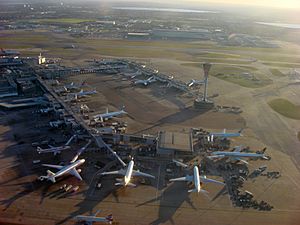
Terminal 3 opened as the Oceanic Terminal on 13 November 1961 to handle flight departures for long-haul routes for foreign carriers to the United States, Asia and other Far Eastern destinations. At this time the airport had a direct helicopter service to Central London from the gardens on the roof of the terminal building. Renamed Terminal 3 in 1968, it was expanded in 1970 with the addition of an arrivals building. Other facilities added included the UK's first moving walkways. In 2006, the new £105 million Pier 6 was completed to accommodate the Airbus A380 superjumbo; Emirates and Qantas operate regular flights from Terminal 3 using the Airbus A380.
Redevelopment of Terminal 3's forecourt by the addition of a new four-lane drop-off area and a large pedestrianised plaza, complete with canopy to the front of the terminal building, was completed in 2007. These improvements were intended to improve passengers' experience, reduce traffic congestion and improve security. As part of this project, Virgin Atlantic was assigned its own dedicated check-in area, known as 'Zone A', which features a large sculpture and atrium.
As of 2013[update], Terminal 3 has an area of 98,962 m2 (1,065,220 sq ft) and in 2011 it handled 19.8 million passengers on 104,100 flights. In May 2015, it was announced that Terminal 3 will be demolished by 2019, when Terminal 2 has been completed.
Terminal 4
Opened in 1986, Terminal 4 is situated to the south of the southern runway next to the cargo terminal and is connected to Terminals 1, 2 and 3 by the Heathrow Cargo Tunnel. The terminal has an area of 105,481 m2 (1,135,390 sq ft) and is now home to the SkyTeam alliance, with the exception of Garuda Indonesia, Middle East Airlines, and Delta Air Lines which use Terminal 3, and to some unaffiliated carriers. It has undergone a £200m upgrade to enable it to accommodate 45 airlines with an upgraded forecourt to reduce traffic congestion and improve security. An extended check-in area with renovated piers and departure lounges and a new baggage system were installed, and two new stands were built to accommodate the Airbus A380; Etihad Airways, Malaysia Airlines and Qatar Airways operate regular A380 flights.
Terminal 5
Terminal 5 lies between the northern and southern runways at the western end of the Heathrow site and was opened by Queen Elizabeth II on 14 March 2008, some 19 years after its inception. It opened to the public on 27 March 2008, and British Airways and its partner company Iberia have exclusive use of this terminal. The first passenger to enter Terminal 5 was a UK ex-pat from Kenya who passed through security at 04:30 on the day. He was presented with a boarding pass by the British Airways CEO Willie Walsh for the first departing flight, BA302 to Paris. During the two weeks after its opening, operations were disrupted by problems with the terminal's IT systems, coupled with insufficient testing and staff training, which caused over 500 flights to be cancelled. Until March 2012, Terminal 5 was exclusively used by British Airways as its global hub; however, because of the merger, on 25 March Iberia's operations at Heathrow were moved to the terminal, making it the home of International Airlines Group.
Built at a cost of £4.3 billion, the terminal consists of a four-storey main terminal building (Concourse A) and two satellite buildings linked to the main terminal by an underground people mover transit system. The second satellite (Concourse C), includes dedicated aircraft stands for the Airbus A380. It became fully operational on 1 June 2011. Terminal 5 was voted Skytrax World's Best Airport Terminal 2014 in the Annual World Airport Awards.
The main terminal building (Concourse A) has an area of 300,000 square metres (3,200,000 sq ft) while Concourse B covers 60,000 square metres (650,000 sq ft). It has 60 aircraft stands and capacity for 30 million passengers annually as well as more than 100 shops and restaurants.
A further building, designated Concourse D and of similar size to Concourse C, may yet be built to the east of the existing site, providing up to another 16 stands. Following British Airways' merger with Iberia, this may become a priority since the combined business will require accommodation at Heathrow under one roof to maximise the cost savings envisaged under the deal. A proposal for Concourse D featured in Heathrow's most recent capital investment plan.
The transport network around the airport has been extended to cope with the increase in passenger numbers. A dedicated motorway spur links the terminal to the M25 (between junctions 14 and 15). The terminal has a 3,800 space multi-storey car park. A more distant long-stay car park for business passengers is connected to the terminal by a personal rapid transit system, which became operational in the spring of 2011. New branches of both the Heathrow Express and the Underground's Piccadilly line serve a new shared Heathrow Terminal 5 station.
Terminal assignments
As of March 2017, Heathrow's four passenger terminals are assigned as follows:
| Terminal | Airlines and alliances |
|---|---|
| Terminal 2 | Star Alliance, Aer Lingus, Eurowings and Icelandair |
| Terminal 3 | Oneworld (except Malaysia Airlines, Qatar Airways, Iberia and most British Airways destinations), Delta Air Lines, Garuda Indonesia, Middle East Airlines, Virgin Atlantic and a few non-aligned airlines |
| Terminal 4 | SkyTeam (except Delta Air Lines, Garuda Indonesia and Middle East Airlines), Malaysia Airlines, Qatar Airways and most non-aligned airlines |
| Terminal 5 | British Airways (most destinations, except those at Terminal 3), Iberia and Iberia Express |
Following the opening of Terminal 5 in March 2008, a hugely complex programme of terminal moves was implemented. This saw many airlines move so as to be grouped in terminals by airline alliance as far as possible.
Following the opening of Phase 1 of the new Terminal 2 in June 2014, all Star Alliance member airlines (with the exception of new member Air India which moved in early 2017) along with Aer Lingus and Germanwings relocated to Terminal 2 in a phased process completed on 22 October 2014. Additionally, by 30 June 2015 all airlines left Terminal 1 in preparation for its demolition to make room for the construction of Phase 2 of Terminal 2.
Some other airlines made further minor moves at a later point, e. g. Air India moving from Terminal 4 to the other Star Alliance carriers in Terminal 2 or Delta Air Lines merging all departures in Terminal 3 instead of a split between Terminals 3 and 4.
Airlines and destinations
Passenger
The following airlines operate regular scheduled passenger flights at London Heathrow Airport:
Cargo
| Airlines | Destinations |
|---|---|
| AirBridgeCargo Airlines | Frankfurt, Moscow-Sheremetyevo
|
| Cathay Pacific Cargo | Delhi, Hong Kong, Milan–Malpensa, Mumbai, Paris–Charles de Gaulle
|
| DHL Aviation | Amsterdam, Brussels, East Midlands, Frankfurt, Madrid–Barajas, Paris–Charles de Gaulle
|
| Emirates SkyCargo | Dubai-Al Maktoum
|
| Ethiopian Airlines Cargo | Addis Ababa, Lagos
|
| Korean Air Cargo | Paris–Charles de Gaulle, Seoul–Incheon
|
| Royal Air Maroc Cargo | Casablanca
|
| Royal Jordanian Cargo | Amman–Queen Alia, Sarajevo
|
| Singapore Airlines Cargo | Abu Dhabi, Amsterdam, Copenhagen, Sharjah, Singapore
|
| Turkish Airlines Cargo | İstanbul-Atatürk |
Other facilities
The head office of Heathrow Airport Holdings (formerly BAA Limited) is located in the Compass Centre by Heathrow's northern runway, a building that previously served as a British Airways flight crew centre. The World Business Centre Heathrow consists of buildings one and two. 1 World Business Centre houses offices of Heathrow Airport Holdings, Heathrow Airport itself, and Scandinavian Airlines. Previously International Airlines Group had its head office in 2 World Business Centre.
At one time the British Airways head office was located within Heathrow Airport at Speedbird House before the completion of Waterside, the current BA head office in Harmondsworth, in June 1998.
To the north of the airfield lies the Northern Perimeter Road, along which most of Heathrow's car rental agencies are based, and Bath Road, which runs parallel to it, but outside the airport campus–this is nicknamed "The Strip" by locals owing to its continuous line of airport hotels.
Access
Public transport
Train
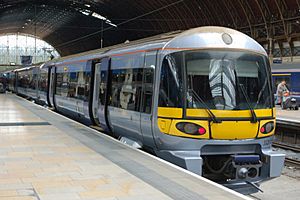
- Heathrow Express: a non-stop service direct to London's Paddington station; trains leave every 15 minutes for the 15-minute journey (21 minutes to/from Terminal 5). Trains depart from Heathrow Terminal 5 station or Heathrow Central station (Terminals 2 & 3). A Heathrow Express transfer service operates between Terminal 4 and Heathrow Central to connect with services from London and Terminal 5.
- Heathrow Connect: a stopping service to Paddington calling at up to five National Rail stations en route – trains leave every 30 minutes for the 27-minute journey. Heathrow Connect services terminate at Heathrow Central station. Calls at Hayes and Harlington for connecting trains to Reading.
- London Underground (Piccadilly line): four stations serve the airport: Terminal 2 and 3, Terminal 4 and Terminal 5 serve the passenger terminals; and Hatton Cross the maintenance areas. The usual journey time from Heathrow Central to Central London is around 40–50 minutes.
- South West Trains has a direct bus transfer to Feltham railway station, allowing passengers to board a train towards Reading or Clapham Junction and London Waterloo.
Bus and coach
Many buses and coaches operate from the large Heathrow airport central bus station serving Terminals 2 and 3, and also from bus stations at Terminals 4 and 5.
Inter-terminal transport
Terminals 2 and 3 are within walking distance of each other. Transfers to Terminal 4 and 5 are by Heathrow Express trains or bus. Heathrow Express and Heathrow Connect train services between Heathrow Central and Terminals 4 and 5 are free of charge. Normal fare rules apply to London Underground services between terminals. Local buses throughout the airport area are provided free of charge under the "Heathrow FreeFlow" scheme; passengers should tell the driver their destination to ensure they are not charged a fare.
Transit passengers remaining airside are provided with free dedicated transfer buses between terminals.
ULTra Personal Rapid Transport opened in April 2011 to shuttle passengers between Terminal 5 and the business car park at a speed of up to 40 km/h (25 mph). There are 21 small transportation pods that can each carry up to four adults, two children, and their luggage. The pods are battery-powered and run on a four-kilometre track. The capsules run on demand. The provider claims a 95% availability rate and no accidents so far. Plans to use the same technology to connect Terminals 2 and 3 to remote car parks were included in the draft 2014–2019 five-year master plan but have since been deferred due to other priorities.
Taxi
Taxis are available at all terminals.
Car
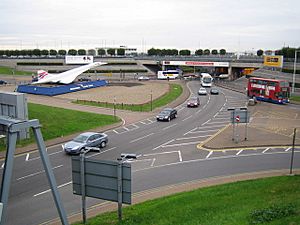
Heathrow is accessible via the nearby M4 motorway or A4 road (Terminals 2–3), the M25 motorway (Terminals 4 and 5) and the A30 road (Terminal 4). There are drop-off and pick-up areas at all terminals and short- and long-stay multi-storey car parks. All the Heathrow forecourts are drop-off only. There are further car parks, not run by Heathrow Airport Holdings, just outside the airport: the most recognisable is the National Car Parks facility, although there are many other options; these car parks are connected to the terminals by shuttle buses.
Four parallel tunnels under the northern runway connect the M4 Heathrow spur and the A4 road to Terminals 2–3. The two larger tunnels are each two lanes wide and are used for motorised traffic. The two smaller tunnels were originally reserved for pedestrians and bicycles; to increase traffic capacity the cycle lanes have been modified to each take a single lane of cars, although bicycles still have priority over cars. Pedestrian access to the smaller tunnels has been discontinued, with the free bus services being used instead.
Bicycle
There are (mainly off-road) bicycle routes to some of the terminals. Free bicycle parking places are available in car parks 1 and 1A, at Terminal 4, and to the North and South of Terminal 5's Interchange Plaza. It is worth noting you are not allowed to cycle through the main tunnel to access Terminals 2 and 3 (Terminal 1 closed in 2015).
Future expansion and plans
Runway and terminal expansion
In January 2009 the Transport Secretary Geoff Hoon announced that the UK government supported the expansion of Heathrow by building a third 2,200-metre (7,200 ft) runway and a sixth terminal building. This decision followed the 2003 white paper on the future of air transport in the UK, and a public consultation in November 2007. This was a controversial decision which met with widespread opposition because of the expected greenhouse gas emissions, impact on local communities, as well as noise and air pollution concerns.
Before the 2010 general election the Conservative and Liberal Democrat parties announced that they would prevent the construction of any third runway or further material expansion of the airport's operating capacity. The Mayor of London, then Boris Johnson, took the position that London needs more airport capacity, favouring the construction of an entirely new airport in the Thames Estuary rather than expanding Heathrow. After the Conservative – Liberal Democrat coalition took power, it was announced that the third runway expansion was cancelled. Two years later, leading Conservatives were reported to have changed their minds.
Another proposal for expanding Heathrow's capacity was the Heathrow Hub, which aims to extend both runways to a total length of about 7,000 metres and divide them into four so that they each provide two, full length runways, allowing simultaneous take-offs and landings while decreasing noise levels.
In July 2013, the airport submitted three new proposals for expansion to the Airports Commission, which was established to review airport capacity in the south-east of England. Each involved the construction of a third runway, either to the north, northwest or southwest of the airport. The commission released its interim report in December 2013, shortlisting three options: the north-west third runway option at Heathrow, extending an existing runway at Heathrow, and a second runway at Gatwick Airport. After this report was published, the government confirmed that no options had been ruled out for airport expansion in the south-east and that a new runway would not be built at Heathrow before 2015. The full report was published on 1 July 2015, and backed a third, north-west, runway at Heathrow. Reaction to the report was generally negative, particularly from London Mayor Boris Johnson. One senior Conservative told Channel 4: "Howard Davies has dumped an utter steaming pile of poo on the Prime Minister's desk." On 25 October 2016 the government confirmed that Heathrow would be allowed to build a third runway; however a final decision would not be taken until winter of 2017/18, after consultations and government votes. The earliest opening year would be 2025.
Heathrow railway hub
A plan to make Heathrow an international railway exchange has also been proposed with the potential construction of Heathrow Hub railway station, built on a link to the High Speed 2 (HS2) railway line. This plan was confirmed to be outside the plans for both Phase 1 & Phase 2 of the plans for HS2 in March 2015.
Airtrack
In July 2009, Heathrow Airport Limited submitted an application to the Secretary of State for Transport seeking to gain authorisation to develop a new rail link to Heathrow Terminal 5 to be known as Heathrow Airtrack. The rail link would address the current lack of public transport available to the South West of the Airport by connecting to Guildford, Reading and London Waterloo. BAA stated that the scheme should add significantly to its aim of increasing the proportion of people using public transport to travel to the airport. In April 2011 BAA announced that it was abandoning the project, citing the unavailability of government subsidy and other priorities for Heathrow, such as linking to Crossrail and HS2.
Heathrow/Gatwick rail link
In late 2011 the Department for Transport began studying the feasibility of a high-speed rail link between Gatwick and Heathrow Airport. This rail link would form part of a plan to combine the UK's two biggest airports into a "collective" or "virtual hub" dubbed Heathwick. The scheme envisages a 35-mile (56 km) high-speed rail route linking the two airports in 15 minutes, with trains travelling at a top speed of 180 miles per hour (290 km/h) parallel to the M25 and passengers passing through immigration or check-in only once.
Heathrow City
The Mayor of London's office and Transport for London commissioned plans in the event of Heathrow's closure—to replace it by a large built-up area. Some of the plans seem to show terminal 5, or part of it, kept as a shopping centre.
Images for kids
-
Heathrow Airport tube and rail stations (Note: The map is outdated as TfL Rail is now the Elizabeth Line.)
-
Entrance at the southern end of the M4 Motorway spur, showing a scale model of Concorde, replaced since 2008 by the Emirates A380 scale model.
See also
 In Spanish: Aeropuerto de Londres-Heathrow para niños
In Spanish: Aeropuerto de Londres-Heathrow para niños


